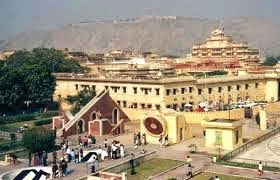On first view this
resembles a rather surreal theme park.
This is Maharajah Jai Singhs open-air astrological observatory and dates back to 1728. With its views of the forts on the Aravalli hills and the giant instruments that lay dotted around - this is an excellent stop if you are touring the city palace.
When you exit the City Palace it is only a 400 ft walk to the entrance to the Jantar Mantar. Unfortunately the walk is a gauntlet of hawkers, beggars, souvenir salesmen and auto-rickshaw drivers. The worst are the children who show no fear in shoving postcards in your face. This was one of the few times in India that I did crack - and when I reached the ticket booth and the man wanted to charge me another 50 rupees for a camera permit - he got a blast on the harassment of tourists in India. But once you are through, the Jantar Mantar is worth all the irritation.
This is Maharajah Jai Singhs open-air astrological observatory and dates back to 1728. With its views of the forts on the Aravalli hills and the giant instruments that lay dotted around - this is an excellent stop if you are touring the city palace.
When you exit the City Palace it is only a 400 ft walk to the entrance to the Jantar Mantar. Unfortunately the walk is a gauntlet of hawkers, beggars, souvenir salesmen and auto-rickshaw drivers. The worst are the children who show no fear in shoving postcards in your face. This was one of the few times in India that I did crack - and when I reached the ticket booth and the man wanted to charge me another 50 rupees for a camera permit - he got a blast on the harassment of tourists in India. But once you are through, the Jantar Mantar is worth all the irritation.
Inside is a lawn covered open area containing the giant instruments that Jai Singh used to view the heavens. They are aligned on the ground and made out of a sherbet-coloured marble that is stained with age. They point at the sky and consist of slants, circles, brick curves and pillars. Most are triangular, but some are semi-circular and all resemble the props from a bizarre science fiction movie.
Near the north wall is one that resembles a 60ft high ski jump. On closer inspection it was a colossal sun-dial - positioned so that its shadow would fall on the surrounding instruments. One of the most memorable was the Jai Prakash Yantra which was two vast hemispheres dug into the ground. It was rather deep and consisted of two curving slabs adorned with centuries old zodiac signs. But the highlight for me was the view of the hills surrounding Jaipur. There, languously draping the summit, was the photogenic Ramalgah fort. So find yourself an instrument, settle down and take your time admiring the view.....




No comments:
Post a Comment